#bournemouth archaeology
Explore tagged Tumblr posts
Text
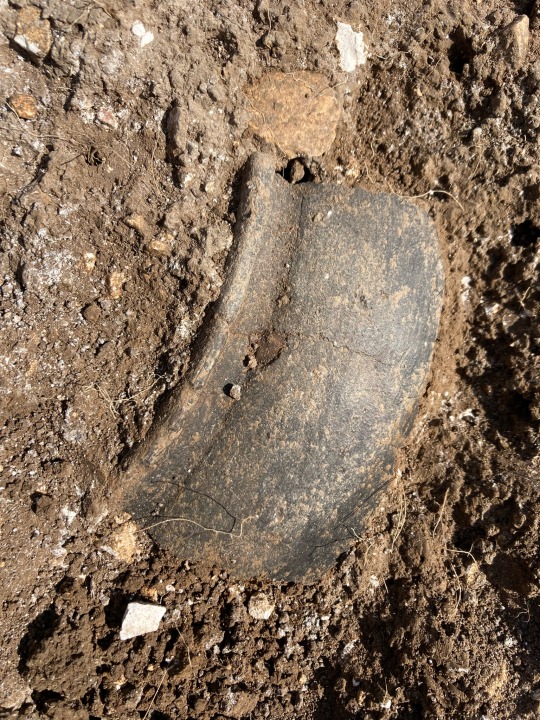
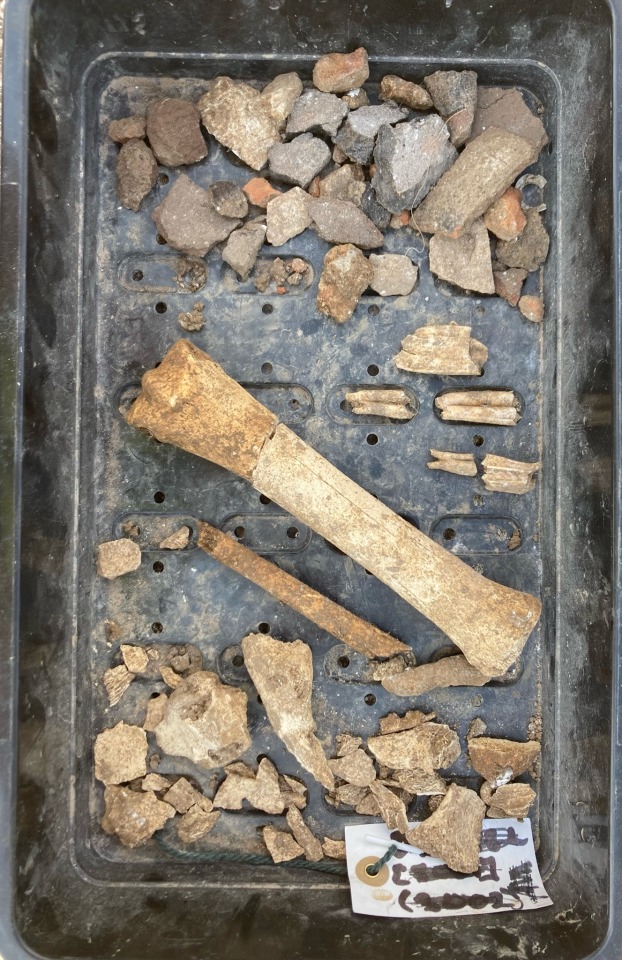
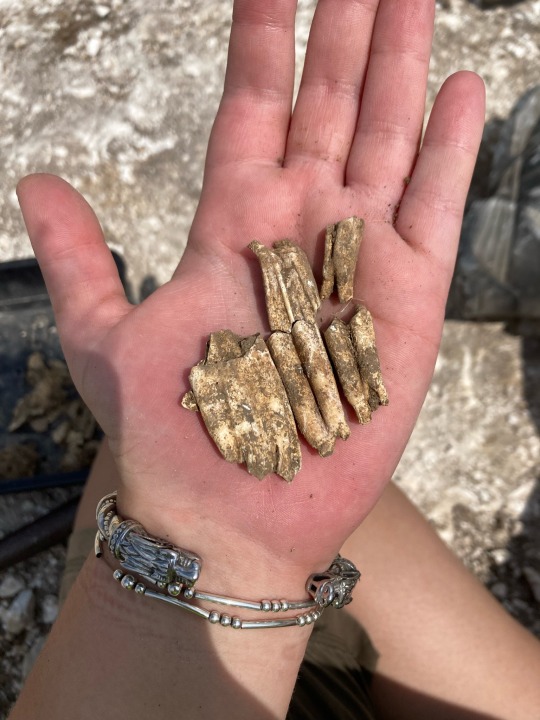
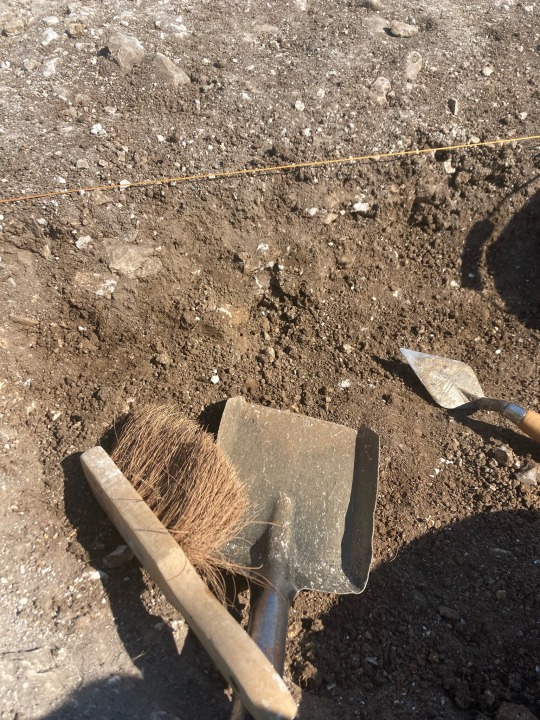
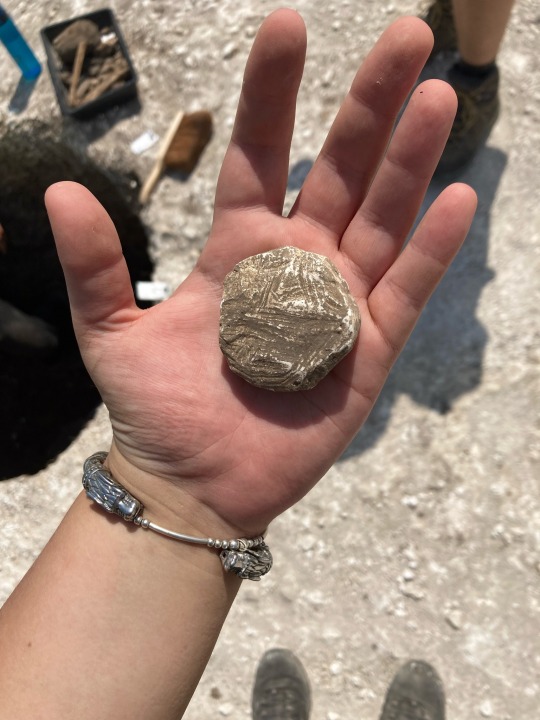
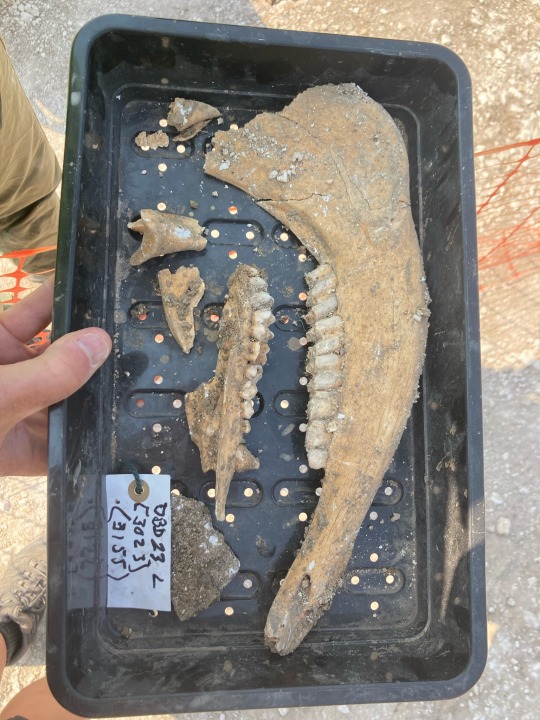
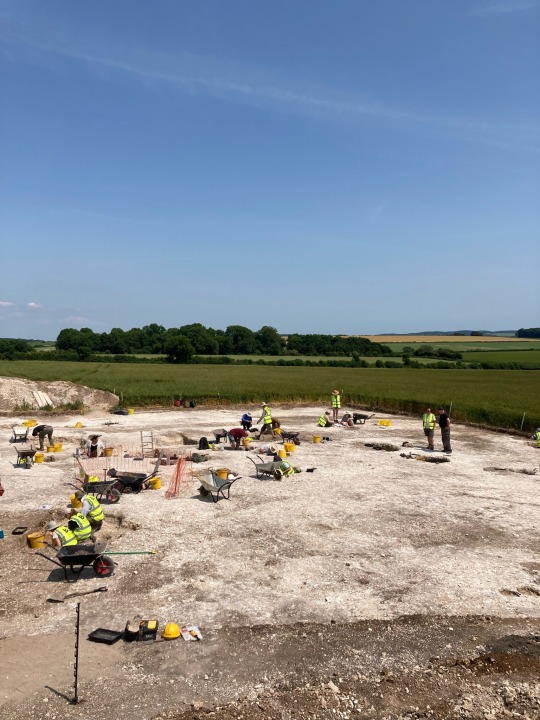

Durotriges ‘23
#archaeology#archeology#bournemouth uni#iron age#iron age society#iron age hillfort#durotriges#durotriges iron age#durotriges tribe#duropolis#dorset#100 BCE#durotriges big dig#BU big dig#bournemouth archaeology#my finds#all photos are mine
1 note
·
View note
Text
Los petroglifos prehistóricos más grandes documentados en Suramérica, participa Natalia Lozada

Los grabados en piedra fueron encontrados en las rocas que rodean el camino del alto y medio río Orinoco entre Colombia y Venezuela. Se trata de representaciones de serpientes, figuras humanas, ciempiés gigantes y figuras geométricas que pueden llegar a medir entre 25 y 40 metros de largo. Según los investigadores que hicieron el hallazgo, se podría considerar que estos grabados rupestres son los más grandes registrados en el mundo.
El equipo de arqueólogos está conformado por Natalia Lozada, profesora del Departamento de Historia del Arte de la Universidad de los Andes (Colombia); Phil Riris, profesor del Institute for the Modelling of Socio-Environmental Transitions de Bournemouth University (Reino Unido) y José Oliver del Institute of Archaeology de la University College London (Reino Unido).Vista del occidente de la sabana del Orinoco y el bosque en galería, tomada desde la cima de un inselberg de granito. Foto de P. RirisFotografía aérea del arte rupestre monumental en Cerro Pintado, Venezuela.

Foto de P. RirisFotografía aérea del arte rupestre monumental en Cerro Pintado, Venezuela. Foto de P. Riris

Fotografía aérea del arte rupestre monumental en Cerro Pintado, Venezuela. Foto de P. Riris
Si bien algunos de los sitios ya eran conocidos, el equipo descubrió varios más y cartografió 14 sitios de grabados rupestres monumentales (aquellos que tienen más de cuatro metros de ancho o alto) con telefotos y fotografías con drones, trabajando con un equipo multidisciplinar y guías locales. «Estos sitios monumentales son sitios verdaderamente grandes e impresionantes, que creemos estaban destinados a ser vistos desde cierta distancia» explica Riris.
Aunque es difícil fechar grabados rupestres, motivos similares utilizados en la cerámica encontrada en el área indican que fueron creados hace más de 1000 años, aunque es posible que sean mucho más antiguos. Muchos de los grabados más grandes son de serpientes, posiblemente boas o anacondas, que desempeñan un papel importante en los mitos y creencias de la población indígena local.Grabados de serpientes monumentales (superposiciones mejoradas). A: Casuarito Norte, ~26 m de largo con animales de perfil y geométricos. B: Palomazón, ~23 m de largo, nótese Scolopendra a la izquierda. C: Maipures-2, ~15 m de largo con motivos animales y humanos; comparar con Casuarito Centro (Figura 2C). D: Pintado, ~42 m de largo, nótese la monumental Scolopendra y el motivo de la máscara (Figura 4A). Humanos para la escala. Longitud de Pintado estimada a partir de imágenes de sensores remotos. Imagen de P. Riris
«Creemos que los grabados podrían haber sido utilizados por grupos prehistóricos como una forma de marcar el territorio, hacer saber a la gente que allí es donde viven y que se espera un comportamiento adecuado. […] Las serpientes generalmente se interpretan como bastante amenazantes, por lo que el lugar donde se encuentra el arte rupestre podría ser una señal de que estos son lugares que demandan respeto» – P. Riris.
Detalle de ortofotografía del arte rupestre monumental de la Isla Picure, Venezuela. Foto de P. RirisDetalle de ortofotografía del arte rupestre monumental de la Isla Picure, Venezuela. Foto de P. RirisImagen mejorada del arte rupestre monumental de la Isla Picure, Venezuela. Foto de P. Riris

Los grabados se concentran principalmente a lo largo de un tramo del río Orinoco, los raudales de Atures, que habría sido una importante ruta comercial y de viaje prehistórica.
«El Orinoco es generalmente bastante navegable hasta este punto, por lo que habría sido una parada obligada. La arqueología nos dice que era un ambiente diverso y había mucho comercio e interacción. […] Esto significa que habría sido un punto de contacto clave, por lo que dejar huella allí podría haber sido aún más importante por eso: para marcar una identidad local y hacer saber a los visitantes que allí está usted y su grupo» – J. Oliver.

Una vista del norte del río Orinoco desde el lado colombiano, tomada desde la cima de un inselberg de granito. Foto de P. Riris
Ir al artículo académico en Antiquity
El equipo publicará los hallazgos en Antiquity, la prestigiosa revista de arqueología, con lo que esperan aportar al conocimiento de estos sitios monumentales de arte rupestre para garantizar su preservación y estudio continuo, proceso en el que también se trabajará junto a las comunidades locales de la región del Orinoco.Natalia Lozada, muestreo de material arqueológico en abrigos rocosos en Colombia. Foto de P. Riris
«Hemos registrado estos sitios en los organismos nacionales de patrimonio de Colombia y Venezuela como es debido, pero algunas de las comunidades a su alrededor sienten una conexión muy fuerte con el arte rupestre y pueden trabajar con los organismos estatales para su conservación y divulgación. En el futuro, creemos que probablemente serán los mejores custodios» – N. Lozada.
La investigación fue financiada por el Leverhulme Trust, The Society of Antiquaries of London, la Universidad de Los Andes, la Fundación de Investigaciones Arqueológicas Nacionales de Colombia y la British Academy. Dentro del equipo de investigación participaron: el arqueólogo Manuel Arroyo Kalin, el arqueobotánico Omar G. Ortiz, la fotógrafa Juanita Escobar, el biólogo Sergio Estrada, los guías locales Juan Carlos García, Ariel Trujillo, Fabian Quiceno, Dumar Chávez y las estudiantes Stephany Gúzman y Mirte Korpershoek.Los raudales de Ventanas desde el lado colombiano. Foto de P. Riris
1 note
·
View note
Photo



Day Six.
Digging in the sweltering heat is never easy and everyone handled the bright sunlight and soaring temperatures wonderfully. There was not a breeze on site, and the people in the trenches were suffering. The features did start to come through nicely, lots of the different colours have started to become visible around trench, which is really great, and an impressive sight especially when no one is on trench; like in the early mornings when the bus hasn't pulled in.
Today was a good day for Hayden on experimental, the furnace is now finally finished, though it did start to crack. The heat made the clay on the outside of the furnace dry but the clay on the inside of it remained wet meaning that the cracks didn't go all the way through; this means that Hayden now has to put more sand in his clay and fill in the cracks in the furnace wall. The furnace is also impressively large, bring on the metal working! Work now begins on a kiln for firing some of the pottery the first years have been making, something which is incredibly exciting!
Photos: Hayden’s finished furnace, a feature appearing in the trenches, and the beginnings of a casting hearth.
#archaeology#british archaeology#medieval archaeology#medieval archaeological excavation#excavation#bournemouth university#experimental archaeology#metallurgy
6 notes
·
View notes
Photo
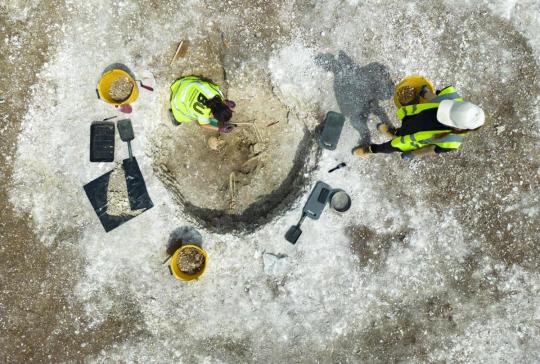
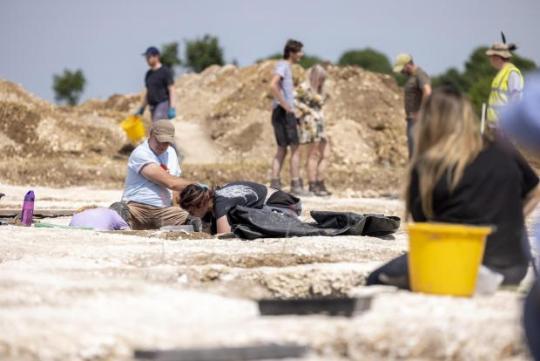
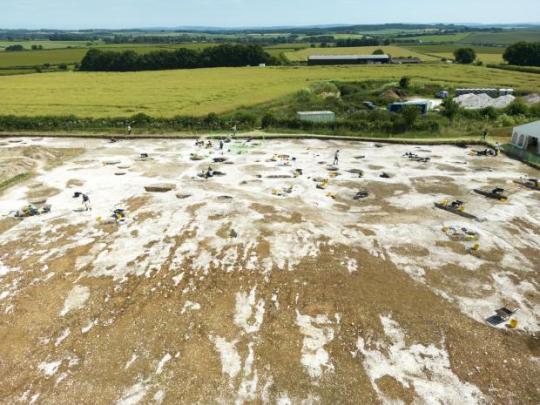
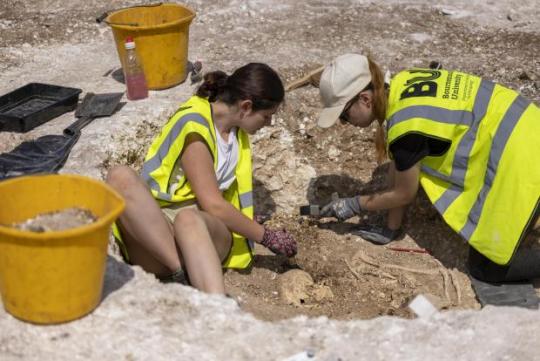
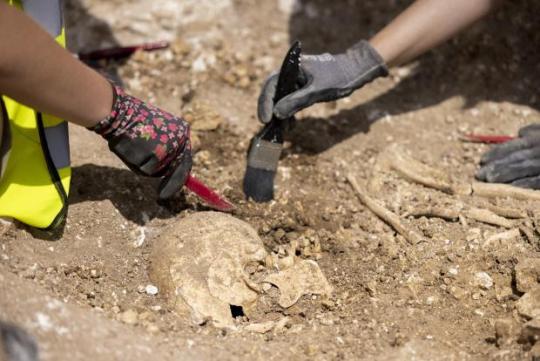
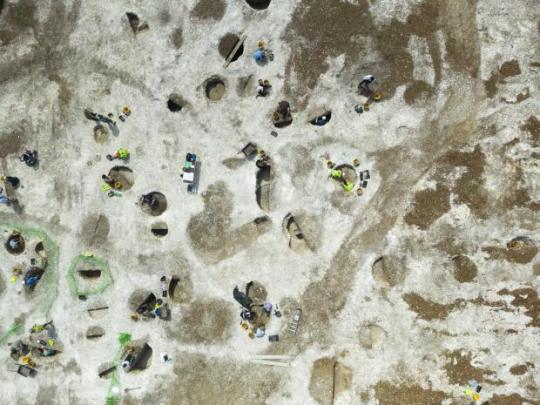
2000-Year-Old Tombs With Five Bodies Discovered in U.K.
Archaeology students have uncovered the 2,000-year-old remains of five bodies on land close to Britain's earliest recorded town.
The historic burial ground which dates to around 100BC, was discovered by university undergraduates on farm land at Winterborne Kingston, near Blandford.
The site is thought to have been an outcrop of the prehistoric town of Duropolis, named after the local Iron Age tribe the Durotriges.
The town, which was discovered in 2008, was older than Colchester and Silchester, which had been regarded as Britain's earliest towns.
The oval shaped settlement of four roundhouses on the outskirts of Duropolis was later abandoned by the group of 40 people who lived there.
Decades later their descendants returned and ceremoniously laid to rest their dead.
The bodies were interned in ditches, originally used to store grain, along with sacrificial animals given as an offering to their pagan gods.
The one acre burial ground was found by students of Bournemouth University last September.
After months of planning and research, excavations began three weeks ago.
So far they have found the remains of three women and two men buried on the site consisting of around 75 ditches, between 3ft and 8ft deep.
They will help to build a 'unique and unparalleled picture' of life for the Iron Age people.
Dr Miles Russell, an archaeologist at Bournemouth University, said: "Iron Age settlements have been found across the country before but finding the people who lived there is really very unique.
"This is such an unusual site because Iron Age people did not tend to bury their dead but here in Dorset it was very different.
"We can see that people in Dorset buried their dead but we have no idea why. These skeletons are providing a whole range of information that you would not find anywhere else in the country.
"Along with the 50 other skeletons we have found in the area over the last decade, they help us to build an unparalleled data set." The oval shaped settlement was built around 100 years before the Roman invasion of Britain.
The pits were originally used to store grain but repurposed as burial units after the farmstead was abandoned in around 30BC.
The discovery sheds new light on the unique burial rites of Iron Age settlers in Dorset.
As an offering to their pagan gods, relatives of the dead placed animal sacrifices beneath their bodies at the bottom of the ditches.
Dr Russell said: "The bodies we found here were buried after the site was abandoned between 30AD and 10AD - the eve of the Roman invasion.
"They were probably descendents of the people who used to live at the farmstead and were taken there to be close to their ancestors. "The pits were originally used to store grain or as cold stores for food. We think they are just a sample of what's beneath the surface and we hope to find more bodies in the coming weeks.
"This would have been quite a small settlement, effectively a prehistoric suburb of the larger Duropolis. We'll do DNA analysis of the skeletons to see how closely related they were to bodies we have found elsewhere in the area.
"We're hoping to slice through time to establish lines of descent, interpersonal relationships, and common ancestry.
"One we're finished, we'll rebury them back in the landscape they would have known.
"This work will give us a vital understanding of ordinary people and their everyday lives and religious practices.
"At the bottom of the pits are sacrificed horses and cows. They were cut into sections and a torso of a cow would have the head of a horse attached to it.
"It is a strange macabre jigsaw of sacred animals offered to their gods. This is information we just would not find anywhere else."
First discovered in 2008, Duropolis was a huge open occupation seen for miles around, at a time when hillforts were still common.
It is the largest unenclosed settlement yet uncovered in the UK and had more than 150 roundhouses in an area of four hectares, as well as storage facilities, animal pens and agricultural outbuildings.
The site shows that towns weren't introduced by the Romans, as many people believed, but existed at least 100 years before they invaded.
The newly-unearthed farmstead is roughly half a mile to the north west of Duropolis.
Once the 65 undergraduates have finished at the current site, they will use sophisticated technology to scan the surrounding areas for further archaeological structures.
#2000-Year-Old Tombs With Five Bodies Discovered in U.K.#archeology#archeolgst#ancient graves#ancient tombs#ancient artifacts#history#history news#ancient history#ancient culture#ancient civilizations
5 notes
·
View notes
Photo

Human footprints thought to be oldest in North America discovered | Archaeology | The Guardian
Ancient tracks found in New Mexico are believed to be between 21,000 and 23,000 years old, study says
New scientific research conducted by archaeologists has uncovered what they believe are the oldest known human footprints in North America.
Research done at the White Sands national park in New Mexico discovered the ancient footprints, with researchers estimating that the tracks were between 21,000 and 23,000 years old, reported Science.
The prints were buried in layers of soil in the national park, with scientists from the US Geological Survey analyzing seeds embedded in the tracks to calculate the age of the fossils. Researchers also determined that the dozen footprints found belonged to a variety of people, mostly children and teenagers.
Previously, scientists had widely assumed that the earliest appearance of humans in the Americas was 11,000 to 13,000 years ago because of stone spears found throughout North America and associated with what is known as the Clovis culture.
“The evidence is very convincing and extremely exciting,” says Tom Higham, an archaeological scientist and radiocarbon-dating expert at the University of Vienna to Nature. “I am convinced that these footprints genuinely are of the age claimed.”
The new research was conducted by experts from White Sands national park, the National Park Service, US Geological Survey, Bournemouth University, University of Arizona and Cornell University.
“The paper makes a very compelling case that these footprints are not only human, but they’re older than 20,000 years,” said Spencer Lucas, a palaeontologist at the New Mexico Museum of Natural History & Science in Albuquerque to Nature. “That’s a gamechanger.”
I absolutely love it! Every time a major new discovery is made, the presumed date of the Americas’ peopling is pushed much further back, often by thousands and thousands of years!
8 notes
·
View notes
Text
Year 1 Week 1
year 1
week 1
day 1
identity and position 5th october
let the tutors know if there are any problems
independent work and collaborative work
learning on studios
developing self directed practise and presentation skills
manage your time 7th december is the deadline meet the deadlines make sure your meet the deadline you have opportunities to succeed take pictures of everything and record the work and the processes of the ideas and work to be professionals know what your work is about
day 2
day 2 (online class) 1000-1245
so we were asked 3 questions:
1. is illustration? A form of art communicating a message or showing a visual idea , recording a plant/ form of life in the wild recording an event unfolding before you (I remember seeing a painting on my trip to Russia of a massacre bloody Sunday) in fact in one could say Communist Russia and Germany when run by Adolf Hitler used art and radio to push their ideology and communicate a positive facade of their horrid plans for their respective countries.Especially illustration in newspapers which at the time people were an important part in human life especially in Europe.Your everyday reliant on newspapers to tell them the truth new shops to check out new restaurants to visit new products and services to buy,2. what is its purpose?- One's expression to bring joy or to just feel and create sometimes there is no reason you just felt like making something - to model or demonstrate a service ( a digital animated character walking) a potential product (iPhone 11pro), building,space,enviroment,scene,character etc.- to communicate ideas,views,opinions,thoughts,irony e.g political cartoons in british newspapers or films - to entertain / divert the masses - film/comic strips in newspapers or online,books,animation,games etc.- to make people think - painting or film or anything Banksy does his instagram is awesome 3. what can illustration do?anything literally it can impact all industries: helping pharmaceuticals and chemists on how to perform an experiment or how the lab should look the possibilities are endless- restaurant menus- visual ideas - storyboards for tv and films et design etc.- product design cars electric devices- where the fire exit signs- online training videos for companies animation for scenarios how to videos - a brand logo apple,The Walt Disney Company, the vue cinema logo etc.From wikipedia - ' Contemporary illustration uses a wide range of styles and techniques, including drawing, painting, printmaking, collage, montage, digital design, multimedia, 3D modelling. Depending on the purpose, illustration may be expressive, stylised, realistic or highly technical.Specialist areas include: Architectural illustration Archaeological illustration Botanical illustration Concept art Fashion illustration Information graphics Technical illustration Medical illustration Narrative illustration Picture books Scientific illustration' here are the groups i was in zoom group 5 answers :an interesting find i find whilst researching :/An illustration is a decoration, interpretation or visual explanation of a text, concept or process,[1] designed for integration in published media, such as posters, flyers, magazines, books, teaching materials, animations, video games and films. An illustration is typically created by an illustrator. Illustration also means providing an example; either in writing or in picture form.The origin of the word “illustration” is late Middle English (in the sense ‘illumination; spiritual or intellectual enlightenment’): via Old French from Latin illustratio (n-), from the verb illustrare' research sites:https://en.wikipedia.org/wiki/Illustration#:~:text=An%20illustration%20is%20a%20decoration,typically%20created%20by%20an%20illustrator. https://www.wordsense.eu/illustrare/ for me illustration is my expression whether via biro pen or watercolours etc. whatever medium this discipline can bring joy it can evoke an emotive memory it can inspire civilians to go to war and 'fight the huns' which many cartoons in newspapers did it during the first world war and second world wars.evoking a sense of comradery a call for heroes a call to 'do your bit' 'keep calm and carry on' and 'do your bit for the war effort'. illustration has the power to communicate an idea or various ideas therefore it has the ability to influence people and inspire and positive or negative reaction illustration and therefore art has power ...where do we get our info or inspo from?the internet - images,text,youtubecinema - filmstv- adverts games - ubisoft's assassin's creed 2,brotherhood what are you inspired by in accordance to the senses?Sensory integration is the process by which we receive information through our senses, organize this information, and use it to participate in everyday activities.An example of sensory integration is: Baby smelling food as they bring it to their mouth Tasting the food Feeling the texture Determining what this food is and if they want more https://pathways.org/topics-of-development/sensory/You read that right! Most people think there are just 5 sense, but there are actually 7! So what are the 7 senses?How might we use these senses in art Sight (Vision) - light the effect of light,everything we see nature social media,traditional media fine art in newspapers, film,photography,books,cartoon,animals,water,rocks,buildings and products,food, clothes,people etc.
Hearing (Auditory) - hearing a problem and trying to figure out how to fix it,hearing sound and figuring how to visualize it or incorporate it
Smell (Olfactory) - thinking of a memory how one felt at a specific time and trying to encapsulate that feeling that emotions and expressing that emotion or how one feels before during and after a smell e.g the air during a hot salty windy day at bournemouth beach
Taste (Gustatory) - memories,good food the feeling of gooey melting chocolate in my mouth trés delicieux!
Demonstrate that in a physical tangible state and or image whether it be traditional analogue on paper perhaps a 3D digital
Touch (Tactile) - textures and grains and movements of a rock of thing feathers and feeling and recreating that or recording it perhaps Vestibular (Movement) - the movement and balance sense, which gives us information about where our head and body are in space. Helps us stay upright when we sit, stand, and walk. - Dance the feeling of a wave hitting the rocks or water against you
Proprioception (Body Position): the body awareness sense, which tells us where our body parts are relative to each other. It also gives us information about how much force to use, allowing us to do something like crack an egg while not crushing the egg in our hands. - inspire to create an animation or a short film of various movements and how the character walks runs etc. various body movement prior to filming character development *FILM/TV/THEATRE mechanical horse like in war horse etc.
* Emotion and feeling - making people feel a different emotion or various emotions feeling empathy or anger making people feel inspired to better society
skills that I am confident in : paying Attention to detail
- Interpersonal and Communication Skills - Teamwork and Multi-tasking - Adobe Photoshop, Illustrator, Lightroom, InDesign, After Effects, Premier Pro and Capture One 10- Drawing- Painting- Illustration- Calligraphy- film and digital Photography as well as editing I care about and hope for :
Our World:- Education for everyone - ignorance is not bliss but a trap to be manipulated and controlled.Critical thinking discussions and emotional and mental growth is a positive thing is is an asset to society.Every human being able to have a full education for them and their needs if they are great at art and history they should not be shamed for not doing good in science!The current Prussian educational system is not helping everyone excel in the subjects they are good at - it was meant for military education in the ancient world after all however we need an improvement.Especially on the teachers hired and trained.Some countries are allegedly failing students just so that they can work in a specific manual labour industries when the kids are intelligent enough to be doctors and scientists they are purposefully failed and told to smash rocks or other manual labour jobs.
I care about the safety and innocence of the next generation globally for kids to be safe from men and woman who want to use them for their own benefit e.g greedy parents,predators,human traffickers and cult leaders
The ending of homeless (people being able to work and have their own home in the UK especially in London)
The end of human trafficking one human forcing another human being to do something for free and forcibly take away their own freedom their God given free will that is not okay to me that will never be okay we are all priceless.
1 note
·
View note
Link
And another “Invasion” theory bites the dust. It’s almost like European & American historians came up with the all these “invasion theories” to justify their own countries grabby-ness. </sarcasm>
1 note
·
View note
Text
Quarrying of Stonehenge 'bluestones' dated to 3000 BC

Excavations at two quarries in Wales, known to be the source of the Stonehenge 'bluestones', provide new evidence of megalith quarrying 5,000 years ago, according to a new UCL-led study.
Geologists have long known that 42 of Stonehenge's smaller stones, known as 'bluestones', came from the Preseli hills in Pembrokeshire, west Wales. Now a new study published in Antiquity pinpoints the exact locations of two of these quarries and reveals when and how the stones were quarried.
The discovery has been made by a team of archaeologists and geologists from UCL, Bournemouth University, University of Southampton, University of the Highlands and Islands and National Museum of Wales, which have been investigating the sites for eight years.
Professor Mike Parker Pearson (UCL Archaeology) and leader of the team, said: "What's really exciting about these discoveries is that they take us a step closer to unlocking Stonehenge's greatest mystery—why its stones came from so far away." Read more.
274 notes
·
View notes
Link
Ancient people moved bodies of the dead from far away to be buried at Stonehenge, a new study finds. The analysis offers the first glimpse of who those people were. Some appeared to have lived more than 200 kilometers (120 miles) away.
Stonehenge is an ancient monument in southern England. It features a ring of massive stones. Underground pits hold human remains. Researchers analyzed some of the remains, which had been cremated and buried around 5,000 to 4,400 years ago.
Some of the rocks that make up Stonehenge came from what is now West Wales. Known as bluestones, these rocks were used in early stages of building the ancient monument. Bluestones are smaller than the massive sandstone boulders that also make up Stonehenge. The new analysis suggests some of the people buried at the site also came from what West Wales.
Ancient societies across southern England and Wales may have been linked. Until now, evidence for those links came from archaeological finds. Still, those links had been “rather shaky,” says Timothy Darvill, who was not involved in the research. The new study, he says, gives more detail about how those ancient societies might have been connected. Darvill is an archaeologist at Bournemouth University in Poole, England.
8 notes
·
View notes
Text
Scientist Reveals How Stonehenge Likely Worked ... and It Works!
Scientist Reveals How Stonehenge Likely Worked … and It Works!
Timothy Darvill, professor of archaeology at Bournemouth University, suggests that Stonehenge is “a simple and elegant perpetual calendar based on the 365.25 solar days in a mean tropical year,” according to a research article published in the journal ANTIQUITY on Tuesday. This calendar included self-correcting mechanisms to ensure accurate timekeeping over the course of years and was used to…

View On WordPress
0 notes
Text
TOP 10 DELLE SCOPERTE ARCHEOLOGICHE 2021 – seconda parte
TOP 10 DELLE SCOPERTE ARCHEOLOGICHE 2021 – seconda parte
Continua e si chiude la rassegna sulle 10 scoperte archeologiche 2021 proposte dalla rivista rivista ARCHAEOLOGY, una pubblicazione dell’Archaeological Institute of America. Per la prima parte, cliccare qui. Buona lettura. Leuhan, Francia. Quando il team di ricercatori guidato da Clément Nicolas, un archeologo della Bournemouth University, ha visto per la prima volta le fotografie d’archivio di…

View On WordPress
0 notes
Note
Oh my gosh!! York is one of my top choices i’m thinking of archaeology at uni of york, winchester, reading, kent and bournemouth I can’t pick… I’ve only ever been to Kent and Winchester and I loved the latter so much but not sure if I should pick a bigger city
omg what a coincidence! I've not been to any of the others but I have heard good things about Winchester! I guess location is massively just personal preference, for me I liked that york has all the shops and restaurants etc you could want but it's still small enough to feel more cosy and I like being able to easily walk around compared to bigger cities
0 notes
Text
Prestigiosas Revistas Nature y Science referencian las Huellas en New Mexico como importante Descubrimiento
.
.
**********************************
.
Esta Página referencia Artículos en Inglés. La Página anterior Referencia los mismos Temas en Español
.
**********************************
.
Revista Nature ----- NEWS - 23 September 2021
Ancient footprints could be oldest traces of humans in the AmericasChildren left tracks in New Mexico around 22,500 years ago — thousands of years before most scientists thought humans settled in North America - by Ewen Callaway
.
Ancient seeds
In 2019, study co-author David Bustos, an archaeologist and resource manager at White Sands, identified a site on the playa that had tracks that led right into layers of rock-hard sediment. The rock contained seeds of spiral ditchgrass (Ruppia cirrhosa), an aquatic plant that could be carbon-dated to determine the age of the tracks. “That’s the holy grail of trying to date footprints,” says Bennett.
He and his colleagues weren’t surprised when radiocarbon dating by researchers at the US Geological Survey in Denver, Colorado, determined that the seeds were between 21,000 and 23,000 years old, because a previous small-scale excavation had dated the sediment to around the same time. But Bennett says the team knew that claims of human occupation at this age would draw extreme scrutiny.
....................
“I really think those ages are okay,” says Thomas Stafford, an experimental geochronologist at Stafford Research Laboratories in Lafayette, Colorado. Even a 1,000-year error wouldn’t tarnish the importance of the footprints, he points out. “Whether people were here 20,000, or 22,000, or 19,000 years ago, does not change their incredible story,” Stafford adds. “We have human footprints.”
.
https://www.nature.com/articles/d41586-021-02597-1
.
**********************************
.
De la Revista Science :
.
Between 23,000 and 21,000 years ago, people squished through the mud along a lakeshore in what is now New Mexico, alone and in small groups, leaving behind their footprints. Or at least that’s the conclusion of a new paper that Oregon State University, Corvallis, archaeologist Loren Davis calls “potentially groundbreaking.” If the dates are right, the discovery would be the strongest evidence yet that people reached the Americas during the middle of the last ice age, thousands of years earlier than many archaeologists thought.
“If that’s true … it’s going to be a revolution in the way that we think about archaeology in the Americas,” says Davis, who wasn’t involved with the work. It might reignite debates about how people first reached the continent from Asia. But Davis and others would like corroboration of the surprising dates before they rewrite their understanding of when and how people arrived.
...................
In recent decades, data from multiple sites have suggested people were in the Americas at least 16,000 years ago, leading many researchers to suspect that the first arrivals skirted the ice by traveling down the Pacific coast by boat.
Human footprints near ice age lake suggest surprisingly early arrival in the Americas
.
If dates hold, tracks would put people in New Mexico thousands of years earlier than thought
.
https://www.science.org/content/article/human-footprints-near-ice-age-lake-suggest-surprisingly-early-arrival-americas
.
**********************************
.
Bennett and his colleagues were able to accurately date 61 footprints by radiocarbon dating layers of aquatic plant seeds that had been preserved above and below them. The prints, which were discovered in the Tularosa Basin in White Sands National Park, were made 21,000 to 23,000 years ago, the researchers found.
The timing and location of the prints in southwestern North America suggests that humans must have been on the continent much earlier than previously thought, Bennett said. The people who made the footprints -- mostly teenagers and children -- were living in New Mexico at the height of the last Ice Age.Between 19,000 and 26,000 years ago, a period known as the Last Glacial Maximum, two massive ice sheets covered the northern third of the continent and reached as far south as New York City, Cincinnati and Des Moines, Iowa.
The ice and cold temperatures would have made a journey between Asia and Alaska impossible during that time, meaning the people who made the footprints likely arrived much earlier.
.................
"That's the important point because it allows you to look at the older sites, the more controversial sites, with a different light."One such site is Chiquihuite Cave in Zacatecas in central Mexico, where flaked stone tools shaped by humans that date back to 30,000 years ago have been found.
-
Fuente :
Fossilized footprints show humans made it to North America much earlier than first thought By Katie Hunt, CNN Updated 1806 GMT (0206 HKT) September 23, 2021
.
https://edition.cnn.com/2021/09/23/americas/footprints-humans-arrive-in-north-america-scn/index.html
.
**********************************
.
De Revista Science :
.
Early footsteps in the Americas
Despite a plethora of archaeological research over the past century, the timing of human migration into the Americas is still far from resolved. In a study of exposed outcrops of Lake Otero in White Sands National Park in New Mexico, Bennett
et al
. reveal numerous human footprints dating to about 23,000 to 21,000 years ago. These finds indicate the presence of humans in North America for approximately two millennia during the Last Glacial Maximum south of the migratory barrier created by the ice sheets to the north. This timing coincided with a Northern Hemispheric abrupt warming event, Dansgaard-Oeschger event 2, which drew down lake levels and allowed humans and megafauna to walk on newly exposed surfaces, creating tracks that became preserved in the geologic record. —AMS
Abstract
Archaeologists and researchers in allied fields have long sought to understand human colonization of North America. Questions remain about when and how people migrated, where they originated, and how their arrival affected the established fauna and landscape. Here, we present evidence from excavated surfaces in White Sands National Park (New Mexico, United States), where multiple in situ human footprints are stratigraphically constrained and bracketed by seed layers that yield calibrated radiocarbon ages between ~23 and 21 thousand years ago. These findings confirm the presence of humans in North America during the Last Glacial Maximum, adding evidence to the antiquity of human colonization of the Americas and providing a temporal range extension for the coexistence of early inhabitants and Pleistocene megafauna.
.
https://www.science.org/doi/10.1126/science.abg7586
.
**********************************
.
Human Footprints in North America more than 21,000 years ago Discovered --- Sep 24, 2021 - Technorites
Human Footprints in North America more than 21,000 years ago Discovered Scientists are describing a set of 23,000-year-old human footprints discovered in New Mexico as the earliest evidence of human activity in the Americas, 10,000 years earlier than previously believed. British and American archaeologists uncovered the prints in soft mud adjoining Alkali Flat, a dry lakebed at White Sands National Park in southern New Mexico. Using radiocarbon dating of seed layers above and below the tracks, experts from the U.S. Geological Survey dated the footprints as having been made over a period of at least 2,000 years, according to research published today in the journal Science.
.
youtube
.
Earliest Human Footprints In North America Found in New Mexico - Sep 24, 2021 - Amaze Lab
And they’re thousands of years older than expected.
.
youtube
.
. Footprints show earliest evidence of people in Americas || Godhuli News BD
.
Title: Footprints show earliest evidence of people in Americas || Godhuli News BD Image Credit to: Reuters ,Getty Images, EPA, News and video collect from BBC. Credit goes to BBC.
Earliest definitive evidence of people in Americas. Humans reached the Americas at least 7,000 years earlier than previously thought, according to new findings. The topic of when the continent was first settled from Asia has been controversial for decades. Many researchers are sceptical of evidence for humans in the North American interior much earlier than 16,000 years ago.
Now, a team working in New Mexico has found scores of human footprints dated to between 23,000 and 21,000 years old. The discovery could transform views about when the continent was settled. It suggests there could have been great migrations that we know nothing about. And it raises the possibility that these earlier populations could have gone extinct. The footprints were formed in soft mud on the margins of a shallow lake which now forms part of Alkali Flat in White Sands.
A team from the US Geological Survey carried out radiocarbon dating on seeds found in sediment layers above and below where the footprints were found. This gave the researchers remarkably precise dates for the impressions themselves. Based on their sizes, scientists think the tracks were made mainly by teenagers and younger children travelling back and forth - along with the occasional adult.
They offer a fascinating window into what life was like for these early occupants of what is now the South West US. The scientists don't know for sure what the teenagers were doing, but it is possible they were helping the adults with a type of hunting custom seen in later Native American cultures. This was known as the buffalo jump and involved driving animals over a shallow cliff edge. The animals "all had to be processed in a short period of time," explained Dr Sally Reynolds, co-author from Bournemouth University. "You'd have to start fires, you'd have to start rendering the fat."
The teenagers could have been helping out by collecting firewood, water or other essentials. The age of the discovery is key, because there have been countless claims of early human settlement in the Americas. But virtually all are disputed in some way. It often comes down to a debate over whether stone tools found at an ancient site are in fact what they appear to be, or are simply rocks broken through some natural process - such as falling from a cliff.
The proposed artefacts at early locales are sometimes less clear-cut than the exquisitely crafted spear-points found in North America from 13,000 years ago onwards. This leaves the door open for doubt about their identity. "One of the reasons there is so much debate is that there is a real lack of very firm, unequivocal data points. That's what we think we probably have," Prof Matthew Bennett, first author on the paper from Bournemouth University, told BBC News.
.
youtube
.
Why Human Footprints Found in NM Are a Big Deal ----- Sep 25, 2021
GMEDIA
Human Footprints Found in New Mexico Date Back to Ice Age
.
youtube
.
Este podría ser tal vez el Video mas interesante de este Tema :
.
Watch Now: Footprints in New Mexico traced back to ice age ---- Sep 24, 2021
.
Tucsondotcom Editors
A new study identifies the oldest human footprints ever found in North America. Video courtesy of NPS/USGS/Bournemouth University
.
youtube
0 notes
Text
Scientists Identify Oldest Human Footprints in North America In Major Find
Scientists have identified the earliest known human footprints in North America, left by people who lived in New Mexico some 23,000 years ago over a period of at least two millennia. Well-preserved and numbering in the dozens, the tracks are about 10,000 years older than the previous record-holder for earliest known footprints on the continent.
The groundbreaking discovery provides “definitive evidence of human occupation of North America” during the Last Glacial Maximum (LGM), when ice sheets extended as far south as New York City, while also shedding light on the “coexistence” of these communities with extinct animals such as giant ground sloths and mammoths, according to a paper published on Thursday in Science.
Though these tracks have been known about for years, a team of scientists have now constrained their exceptional age by radiocarbon-dating two layers of preserved aquatic seeds deposited above and below them.
“If you'd asked most people in the archaeological community a few years ago what the earliest site in the Americas would look like, we would have said we’d need hearths that could be dated; a few human teeth would be great so we could do genetics work; and some other human bones would be fabulous, and definitely some older-looking stone tools,” said Sally Reynolds, a mammalian paleontology at Bournemouth University who co-authored the study, in a call.
“Yet here we have the story of the earliest human presence in North America being told without stones, bones, or hearths, but by footprints and two seed layers,” she continued. “It shows you that in science, one has to be very open to the wealth of evidence that you sometimes get when you do archeological excavations.”
The White Sands footprints are known as “ghost tracks” because they are only visible in certain light and moisture conditions. Reynolds and her colleagues have been studying the fossils for the past five years, and have already published research indicating that humans in this area stalked and harassed sloths, offering a rare window into the behavior of both species during this period.
However, the new study is the first to definitively confirm the unprecedented age of these footprints, a finding that has widespread implications for reconstructing the mysterious origins of humans on the North American continent.
The advance of ice during the LGM blocked migration routes from Asia into North America, prompting many scientists to doubt that our species could have arrived on the continent earlier than about 16,500 years ago, when these barriers receded. However, tantalizing potential traces of humans before that timeframe have turned up here and there, suggesting that a small population may have migrated to the continent before the LGM.
Reynolds and her colleagues, including lead author Matthew Bennett also of Bournemouth University, have now presented the most robust evidence that humans were able to slip through to the continent before the glacial portcullis was drawn up.
“Our work has shown that the ice sheets were probably controlling entry into North America, but that we had made it in one glacial cycle earlier,” Reynolds said. “Working back from that, we think that at around 30,000 years ago, humans would have traveled from Siberia over the Beringia land bridge.”
“This migration route only existed when there was some ice to lower the sea levels, but not enough ice to close the two ice sheets, so that constrains some of our timing,” she added. “It is a very exciting step change in how we understand the stages of this most important migration into North America.”
In addition to stretching back the empirical timeline of humans on the continent, the footprints contain insights about the people who lived in White Sands so many millennia ago. A lot of the tracks were made by children, which is a bias that exists in other human footprint sites around the world. Like kids today, these youngsters were probably running around, stomping, and playing more than adults, thereby leaving more footprints behind. Likewise, many of the tracks also belong to teenagers who might have been carrying out tasks on behalf of older members of their community, or just idling around together.
The presence of mammoth and sloth tracks alongside the human footprints also implies that humans during this period were hunting enormous prey. While overhunting by humans has been implicated in the later extinctions of these large animals, the White Sands tracks suggest that this earlier population managed their prey sustainably over a period of about 2,000 years, probably because it was so much smaller than later migrations.
Now that the researchers have snagged such compelling proof that humans inhabited North America prior to the LGM, they are eager to search for more traces of these trailblazers in places like Alaska, a major gateway to the continent, as well as in White Sands, where these ghost tracks have just offered a new window into our shared human past.
“It's just mind blowing the level of information we could actually get from this site, and I'm really excited at what the future will bring,” concluded Reynolds. “That's why we're also pleased that we might be able to tell the world about this and then move on, because we're so excited to focus on the future work.”
Scientists Identify Oldest Human Footprints in North America In Major Find syndicated from https://triviaqaweb.wordpress.com/feed/
0 notes
Text
Thousands of ancient Islamic tombs found mysteriously arranged in 'galactic' patterns
https://sciencespies.com/humans/thousands-of-ancient-islamic-tombs-found-mysteriously-arranged-in-galactic-patterns/
Thousands of ancient Islamic tombs found mysteriously arranged in 'galactic' patterns

Thousands of medieval Islamic tombs in eastern Sudan were arranged in hard-to-detect patterns, with sacred “parent” tombs hosting subclusters of emanating burials, according to archaeologists who studied the funerary monuments with a method designed for cosmology.
The team used satellite imagery to identify the locations of more than 10,000 monuments in the Kassala region of eastern Sudan. The monuments include tumuli, which are made of stone and are “relatively simple raised structures, widespread throughout African prehistory and history,” and “qubbas,” which is a term that referred to Islamic tombs and shrines in the pan-Arab world, a team of researchers wrote in a paper published July 7 in the journal PLOS One.
Related: Photos: 3,400-year-old tomb along the Nile River
After the team mapped the funerary monuments, they had trouble interpreting the data, given that few of the monuments had been excavated.
“We faced the challenge of interpreting the creation of the funerary landscape with almost no traditional archaeological data, but [we had] a large enough data set to be able to hypothesize the presence of complex processes both at regional and local scale[s],” Stefano Costanzo, a doctoral student in archaeology at the University of Naples L’Orientale in Italy and lead author of the journal article, told Live Science.
“To the naked eye, it was clear that the clustered tombs were conditioned by the environment, but deeper meaning may have been implied in their spatial arrangement,” Costanzo said.
He and other members of the team searched for statistical modeling techniques that could help them detect patterns. Ultimately, they decided on a method called the Neyman-Scott cluster process, which was originally developed to study the spatial patterns of stars and galaxies. As far as the team knows, archaeologists have never used the technique.
Related: The 15 weirdest galaxies in our universe
“The biggest feature of this model lies in the fact that it can deal with archaeological data sets that [lack excavation data and historical records] but are composed of a very large number of elements, which is the basis to meaningful statistical analyses,” Costanzo said.
The modeling technique revealed that the Islamic tombs “were hiding several subclusters revolving around unidentifiable ‘parent’ tombs that acted as centers of attraction for subsequent burials, seemingly driven by general sacredness of the location and social trajectories of still existing mobile groups,” said Constanzo.
The study also confirmed that areas where building material was readily available also tended to have more tombs and that environmental factors, such as the topography of the landscape, could also affect where tombs are located.
The Kassala region is inhabited by the Beja people, many of whom still live a semi-nomadic lifestyle, the team said in the journal article.
“The local clusters are most probably tribal/family cemeteries of the Beja people,” the team wrote in the article. More research is needed to determine the precise locations of the “parent” tombs. Further research could also reveal who was buried in these parent tombs and what made them so special.

Landscape view of qubba tombs, Jebel Maman. (Stefano Costanzo,CC-BY 4.0)
Interesting archaeological method
Scholars not affiliated with the research said the team’s methods and findings were interesting.
“The approach is well suited to the investigation of nomadic groups, which range over vast territories,” said Derek Welsby, an assistant keeper (similar to a curator) at the British Museum who has done extensive archaeological research in Sudan. The research should make future excavations in the area easier said Welsby.
The cosmological technique the team used “looks like quite an interesting and potentially valuable addition to archaeology’s already quite large arsenal of statistical methods for gaining insights into the development of landscapes like these,” said David Wheatley, an archaeology professor at the University of Southampton in the United Kingdom.
It also provides information on the history of the people who live there. “It provides quantitative support for the deep history of the Beja people,” said Giovanni Ruffini, a history professor at Fairfield University in Connecticut.
“Modern scholars have relied on scattered references in literary texts to write Beja history, and the results just aren’t satisfying,” said Ruffini, who has conducted extensive research into medieval Sudan.
One scholar did suggest one limitation of the study, however.
Philip Riris, a lecturer in archaeological and paleoenvironmental modeling at Bournemouth University in the United Kingdom, expressed concern that the team included tombs from vastly different time periods in the same model. This “is risky because different funerary traditions are all thrown together,” Riris said.
Related content:
10 epic battles that changed history
25 grisly archaeological discoveries
7 bizarre ancient cultures that history forgot
This article was originally published by Live Science. Read the original article here.
#Humans
0 notes
Text
Top 10 Summer Destinations in the UK
1. London
If you are looking to immerse yourself in the busyness of the hustle and bustle of the city then visit London. It offers the iconic London Eye, Big Ben, and Westminster. Overcome your fear of heights, visit the shard, or enjoy the beautiful Gherkin and see its beautiful architecture. If you’re looking to shop, then enjoy yourself in Oxford street as you lose yourself in the many retail stores it has waiting for you. Eat away and explore the diversity of London as you taste away in London’s Borough Market or Camden market.
2. Lake District
If you’re looking for a quiet getaway to cherish mother nature, then Lake District is the place for you. If you're feeling energetic why not hike up Lake district and camp amidst the beautiful view of the Lake. Lake District National Park is popular for its stunning scenery, abundant wildlife, and cultural heritage. Its special qualities include: Cool, clear lakes, tarns and rivers - nationally important stretches of water for their range of habitats, and species such as vendace, charr, crayfish, and schelly.

3. Cornwall
Cornwall is popularly known for its Celtic history, but it also offers a coastline located in the southwest of the UK. Let’s be frank, charming seaside trips are amazing. I mean, at the first sight of (sunshine or dry even dry weather for that matter) us Brits rush to the sea. It’s in our blood! Especially in Cornwall, where there’s a whole heap of pretty seaside towns and coastlines to explore. If you’ve never had a seaside holiday in England before then you’re in for a beautiful and mouth-watering treat. Most are filled with some of the tastiest fish and chip shops (add a few splashes of vinegar), lots of tearooms, and plenty of local pubs (a favourite once the sun starts to set) – with Cornwall being of no exception. With all the little hamlets, rugged rocks, and the kind of beaches that make you want to stay all day – you won’t want to leave this gorgeous area of England.
Some of the popular routes are
Glasgow taxi
London taxi
Norwich taxi
Abingdon taxi
Aldershot taxi
Andover taxi
Ashford taxi
Aylesbury taxi
Banbury taxi
Barnstaple taxi
Basildon taxi
Basingstoke taxi
Bath taxi
Bedford taxi
Bicester taxi
Birmingham taxi
Blackburn taxi
Bolton taxi
Bournemouth taxi
Bracknell taxi
4. Bath
Located in Somerset, Bath is rich in culture and history. It is the largest city in the county of Somerset, known for and named after its Roman-built baths One of the popular places to visit in Bath is the medieval Bath abbey along with its roman built bath. If you're exploring architecture, then why not try the royal crescent, an arc formed by Georgian townhouses designed by John Wood. Soaked in history Bath has plenty of places to visit, from The Circus and Stonehenge, Bath’s Many Crescents, and already mentioned Bath abbey.
5. Bournemouth Dorset
A genteel Victorian seaside resort on the South Coast of England, Bournemouth cultivates a polished, stately image. This has much to do with its many gardens, planted with sub-tropical species like palms and ferns that thrive in the town’s warmer microclimate. Bournemouth has some of the warmest sea temperatures in England, on seven miles of coast that includes four Blue Flag beaches, held as some of the best England has to offer. These beaches are hemmed by green cliffs, and you can use funicular railways built in Bournemouth’s Victorian heyday to get down. In a few spots, the cliff is broken by a ravine, known on the South Coast as a chine, and often landscaped with gardens. From the Hengistbury Head Beach to the Oceanarium to the West Cliff lift to the ever-popular Bournemouth Pier, it is full of eye-catching spectacles.
6. Edinburgh
The capital of Scotland, Edinburgh has got to be one of the most mysterious cities in Europe. Its dark, medieval walls hold so many secrets, most of which we probably don’t even know about boasts itself for its well-known Edinburgh castle. Uncover the history and visit the Scottish crown Jewel in the Royal places well as the Scottish national war memorial and the famous stone of destiny. Edinburgh is touted as the greenest city in the United Kingdom, the place exudates lush trees and plants everywhere. It is also known for the widely popular Edinburgh Fringe festival fare, the largest arts festival globally. All in all, it is a must summer destination in the UK.
7. Stonehenge in Salisbury
Stonehenge, prehistoric stone circle monument, cemetery, and archaeological site located on Salisbury Plain, about 8 miles north of Salisbury, Wiltshire, England. It was built in six stages between 3000 and 1520 BCE, during the transition from the Neolithic Period to the Bronze Age. As a prehistoric stone circle, it is unique because of its artificially shaped sarsen stones (blocks of Cenozoic silcrete), arranged in post-and-lintel formation, and because of the remote origin of its smaller bluestones from 100–150 miles away, in South Wales. Quench your thirst in history as you visit the world's oldest heritage site. Originally known as a place of worship it is now a popular tourist site. Salisbury holds one of the most popular cathedrals that goes far back to the Magna Carta.
8. Jurassic Coat
The Jurassic Coast is a World Heritage Site on the English Channel coast of southern England. It stretches from Exmouth in East Devon to Studland Bay in Dorset, a distance of about 96 miles, and was inscribed on the World Heritage List in mid-December 2001. The word Jurassic makes everyone think of dinosaurs. Yes, you won't be seeing dinosaurs but you can discover fossils from nearly 92 million years ago. With the cliff slowly eroding more and more fossils are released so be the first to set eyes on these fossils. Why not make the most of your day with places such as Durdle Door and Old Harry’s Rock why not make the most of your day.
9. St Michael’s Mount Cornwall
This tidal island is one of the marvellous festival fares in the UK. The island is a civil parish and is linked to the town of Marazion by a man-made causeway of granite setts, passable between mid-tide and low water. The legend that coexists with it says that giants still inhabit the cave on the island. Go see for yourself whether this is just a legend or whether the existence of such giants can be proved.
10. Bristol Clifton suspension bridge
Located in the Southwest of England this city encompasses the river, Avon. Its wealthy maritime history and M shed museum allows you to discover the social and industrial heritage. The Clifton Suspension Bridge is a suspension bridge spanning the Avon Gorge and the River Avon, linking Clifton in Bristol to Leigh Woods in North Somerset. Since opening in 1864, it has been a toll bridge, the income from which provides funds for its maintenance. The suspension bridge built by Isambard Kingdom Brunel is a recognizable structure with its spectacular view of the Avon Gorge is a must-see.
0 notes